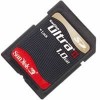SanDisk SDSDH-1024 Product Manual - Page 9
Hot Insertion, SD Card-SD Bus Mode
 |
UPC - 710348911073
View all SanDisk SDSDH-1024 manuals
Add to My Manuals
Save this manual to your list of manuals |
Page 9 highlights
Revision 2.2 Chapter 1 - Introduction SanDisk SD Card Product Manual 1.11 Hot Insertion Support for hot insertion will be required on the host but will be supported through the connector. Connector manufacturers will provide connectors that have power-pins long enough to be powered before contact is made with the other pins. This approach is similar to that used in PCMCIA and MMCA devices to allow for hot insertion. 1.12 SD Card-SD Bus Mode The following sections provide valuable information on the SD Card in SD Bus mode. 1.12.1 SD Card Standard Compliance The SD Card is fully compliant with SD Card Physical Layer Standard Specification v1.10. The structure of the Card Specific Data (CSD) register is compliant with CSD Structure 1.0. 1.12.2 Negotiating Operating Conditions The SD Card supports the operation condition verification sequence defined in the SD Card standard specifications. Should the SD Card host define an operating voltage range, which is not supported by the SD Card it will put itself in an inactive state and ignore any bus communication. The only way to get the card out of the inactive state is by powering it down and up again. In Addition the host can explicitly send the card to the inactive state by using the GO_INACTIVE_STATE command. 1.12.3 Card Acquisition and Identification The SD Card bus is a single master (SD Card host application) and a multi-slaves (cards) bus. The Clock and Power lines are common to all cards on the bus. During the identification process, the host accesses each card separately through its own command lines. The SD Card's CID Register is pre-programmed with a unique card identification number, which is used during the identification procedure. In addition, the SD Card host can read the card's CID Register using the READ_CID command. The CID Register is programmed during the SD Card testing and formatting procedure, on the manufacturing floor. The SD Card host can only read, and not write, this register. An internal pull-up resistor on the DAT3 line may be used for card detection (insertion/removal). The resistor can be disconnected during data transfer (using ACMD42). Additional practical card detection methods can be found in SD Physical Specification's application notes given by the SDA. 1.12.4 Card Status The card status is separated into the following two fields: • Card Status is stored in a 32-bit status register that is sent as a data field in the card response to host commands. The Status Register provides information about the card's current state and completion codes for the last host command. The card status can be explicitly read (polled) with the SEND_STATUS command. © 2004 SanDisk Corporation 1-5 12/08/04















